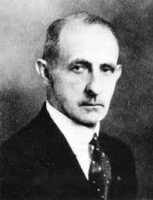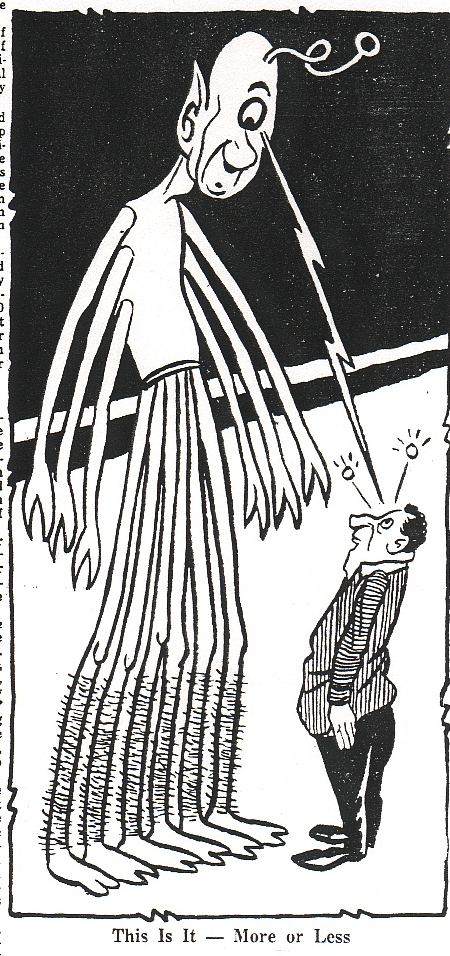By Charles Lear
 In 1953, there were several UFO reports throughout the year in Canada around the area of Sudbury, Ontario. Reports ranged from saucers to cigar-shaped objects, and there was one report of two “flying torpedoes” that moved slowly in the sky and made no sound. Then, in 1954, there was a report from nearby Garson of a craft and three bizarre creatures that may have had malevolent intentions.
In 1953, there were several UFO reports throughout the year in Canada around the area of Sudbury, Ontario. Reports ranged from saucers to cigar-shaped objects, and there was one report of two “flying torpedoes” that moved slowly in the sky and made no sound. Then, in 1954, there was a report from nearby Garson of a craft and three bizarre creatures that may have had malevolent intentions.

The case was investigated by Buffalo, New York, minister Elder Charles Beck, who had a religious radio show where he also shared UFO stories. Beck was member of Borderland Sciences Research Associates, which was an organization devoted to the paranormal and esoteric that was founded in 1945 by Meade Layne, Max Freedom Long and like-minded thinkers. BSRA has the distinction of investigating a UFO report in 1946, which was, as far as this writer is aware, the first private organization to have done so in the modern flying saucer/UFO era. The reported object, seen at night near the moon, was said to have had flapping wings shaped like those of a butterfly. BSRA member Mark Probert claimed he was told “clairaudiently” that the object was a mechanical bird from a far-off planet and that it was called a “Kareeta.”
BSRA put out a publication called Round Robin and the Garson case was written about by Edward S. Schultz in an article headlined “Space-Craft Landing in Canada” that was published in the July-August 1954 edition.
Beck found out about the Garson case from a July 7, 1954 International News Service report. According to the report, “A young Canadian miner is insisting he saw a flying saucer and its crew of three – ‘all thirteen feet tall with ears like spurs and three sets of arms.’” The miner, 23-year-old Ennio LaSarza, told his story to the RCAF and they investigated. He said he “asked the creatures from a distance who they were and ‘they fixed me with a hypnotic stare until I fainted: when I came to they and the ship had vanished.’”
According to Schultz, Beck read the INS report and went up to Canada on July 9. He got together with Sudbury Daily Star reporter Michael Bolton and they interviewed LaSarza for four hours. Beck had a tape recorder with him and recorded either all or part (Schultz doesn’t make this clear) of the interview. Then, LaSarza became concerned that he might have violated promises he’d made to the RCAF and asked Beck to erase the tape. Beck complied and erased the tape in LaSarza’s presence.
According to Schultz, Beck and Bolton went to the Daily Star offices and made a tape based on their memory of the interview. On July 11, the tape was broadcast from a Buffalo radio station and Schultz wrote, “I in turn made a recording of the story, which corrects some of the errors in the press reports…”
In Schultz’s version, LaSarza was working on a painting job on the property of the nickel mine where he worked when he saw an object coming down going “several times the speed of a jet plane.” He thought it was going to crash, but it stopped and hovered just above the ground. He said the ground beneath was scorched, but according to Schultz, the “mining officials” wouldn’t give Beck “and others” access to the spot.
LaSarza described the object as spherical, 25 feet in diameter, with portholes around it. He said there were “rudiments” of landing gear and that there was an antenna on top.
 He said three creatures came out of the object. According to Schultz, LaSarza described them as being about 13 feet tall, greenish-blue, and said their faces were “a color combination he had never seen before.” They “seemed to glow,” had a single eye in the middle of their “foreheads,” and two antennas. They had six legs, and six arms with “crablike claws, which opened and closed spasmodically.”
He said three creatures came out of the object. According to Schultz, LaSarza described them as being about 13 feet tall, greenish-blue, and said their faces were “a color combination he had never seen before.” They “seemed to glow,” had a single eye in the middle of their “foreheads,” and two antennas. They had six legs, and six arms with “crablike claws, which opened and closed spasmodically.”
One of the creatures approached LaSarza, and as he turned to run, the creature “sent a sort of hypnotic stare after Ennio that ‘froze’ him in his tracks…” LaSarza then heard a voice in his head that “sternly requested or instructed Ennio to perform some task, the nature of which he has stoutly refused to divulge, even to officialdom.”
In the newspaper business, summer is notorious for being a slow news period, and is known as “the silly season” due to editors turning to amusing human-interest stories to fill out their papers. LaSarza’s story came out in July, and this may have been a factor in its being reported in the local papers and being picked up by the INS wire service. The reporting ranged from a short, simple description in the INS report to an illustrated three-column article in the July 13, 1954 Sudbury Daily Star emphasizing the more sensational aspects of the story.
In the Star article, Beck is quoted extensively throughout. According to him, Sudbury was “to be the center of activity because of the nickel mines here.” He said the saucers were “interested in atomic energy and any kind of mines.” He added that the saucer people were among the populace “walking your streets, mingling with your people here, even in your plants. They know every word between your public officials.”
Perhaps trying to fit what LaSarza reported into the context of some sort of narrative, he compared the Garson creatures to the creature reported in 1952 in Flatwoods, West Virginia. According to his (or possibly the reporter’s) inaccurate recounting of the witnesses’ descriptions of that creature, it “had a greenish-blue body, a reddish face, six pincer-tipped arms and six legs and stood 15 feet tall – exactly the same type of creature seen by LaSorza (LaSarza’s name is misspelled thoughout the article) at Garson – except the one the miner saw had only one eye.”
In the Round Robin article, Schultz speculates that the unspeakable task given to LaSarza by the creature had something to do with the nickel mine. He tells the reader that “26 percent of natural nickel consists of the isotope nickel 60.” He explains that if nickel 60 is “bombarded with neutrons,” nickel 60 will “burp out a proton” and become highly radioactive cobalt 60.
Schultz wonders if the creature might have instructed LaSarza to place a “neutron generating fuse gadget that would change a mine full of nickel into cobalt 60.” According to Shultz, this would create an area of concentrated radioactivity hitherto unprecedented on Earth. He wonders if it might achieve critical mass and explode, trigger huge earthquakes, or contaminate the atmosphere.
Shultz asks: “Would this be necessarily a malignant move – or would it be a lesser evil gesture on the part of the Space Guardians, i.e., to wipe out the human race to forestall our blowing the planet apart with our atomic experiments? From their viewpoint this might amount to killing off the pupils to save the school.”
The writer wishes to thank David Marler for his contribution of the Round Robin article and a file on the case from his archives, and his permission to upload the article to archive.org.